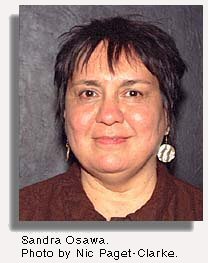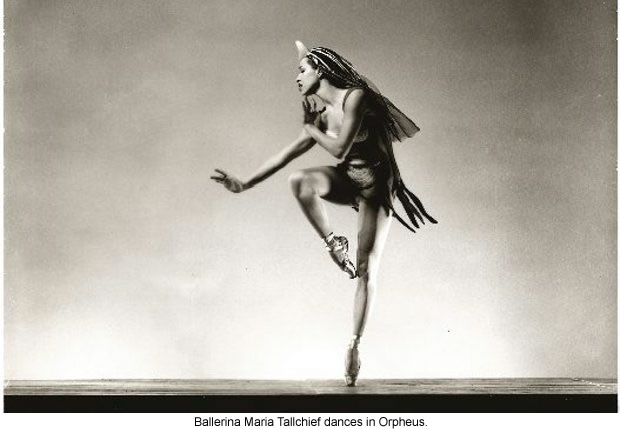 |
Canku Ota
|
 |
|
(Many Paths)
|
||
|
An Online Newsletter
Celebrating Native America
|
||
|
March 1, 2010 - Volume
8 Number 3
|
||
|
|
||
|
Film Tells Success
Story Of Native Ballerina
|
||
|
by Adrian Chamberlain
- Victoria (BC) Times Colonist
|
||
 In
the world of independent documentaries, the fight against stereotyped
views of indigenous people continues, says a native American filmmaker
from Seattle. In
the world of independent documentaries, the fight against stereotyped
views of indigenous people continues, says a native American filmmaker
from Seattle. "We're still in a struggle, a battle, really," said Sandy Sunrising Osawa, who shot a documentary on ballerina Maria Tallchief set to screen in Victoria on Monday. As an indy filmmaker, she says it is easier to get funding for documentaries about the social issues native Americans grapple with -- such as poverty -- than films about those who excel in a given field. As well, U.S. public television and film festivals appear to favour social-problem documentaries. "Again and again, the same victim story seems to be selected for prime time ... There's still some work to be done," Osawa said. The veteran filmmaker -- a Makah tribal member -- travels to the University of Victoria for a free showing of Maria Tallchief: America's Prima Ballerina (2007). Osawa will give a talk about her documentary, which chronicles the journey of a native American who, in the 1940s and '50s, became a globally celebrated ballerina. It was an amazing accomplishment. As well as combating the once prevalent notion that only Europeans could excel in ballet, Tallchief transcended racial prejudice against native Americans at the time. For the film, which has already aired on PBS, Osawa did extensive interviews with 85-year-old Tallchief. She describes her as a "very strong" and "a regal presence." Tallchief's father was a chief of the Osage Nation in Fairfax, Okla. A shy girl, she studied in California with Bronislava Nijinska, sister of dance legend Vaslav Nijinsky. Tallchief joined the Ballet Russe de Monte Carlo and married famed choreographer George Balanchine. Mesmerized by her artistry, he created for her such seminal works as Orpheus (1948) and Firebird (1949).
She and Balanchine formed the New York City Ballet, where Tallchief was prima ballerina from 1947 to 1960. Her fame landed her on the cover of Newsweek; President Dwight Eisenhower once declared her "Woman of the Year." Tallchief's technical prowess was said to be jaw-dropping. Legend has it dance critic Edward Denby was so affected by her performance in Orpheus, he slumped over in his seat. Archival segments of Orpheus and Firebird are included in Maria Tallchief: America's Prima Ballerina. In addition to commentary by Tallchief herself, the documentary has interviews with colleagues and dance historians. Despite once being a superstar, Tallchief's name isn't particularly known outside the dance world today, Osawa says. "There's a generational gap," she said. "Many people, several generations now, haven't heard of her. Possibly don't know her. The [documentary] fills an important void there, I think." Osawa, who collaborates with husband Yasu Osawa, has a special interest in the lives of native artists. Her previous documentaries include On and Off the Res w/Charlie Hill (2000) -- about a First Nations man's quest to become a standup comic -- and Pepper's Pow Wow (1996), about pioneering musician Jim Pepper, who melded jazz with Native American music. This is the last year PBS has the rights to air Maria Tallchief: America's Prima Ballerina. After that, the focus will be on educational screenings in schools and universities such as UVic. Osawa enjoys these events, because she gets the opportunity to see audiences react first-hand. She is especially touched at how some First Nations people respond to the Tallchief documentary. "Native women particularly say how emotional it is for them. They have cried because it is so inspiring." |
|
|
||
|
|
||
| Canku Ota is a free Newsletter celebrating Native America, its traditions and accomplishments . We do not provide subscriber or visitor names to anyone. Some articles presented in Canku Ota may contain copyright material. We have received appropriate permissions for republishing any articles. Material appearing here is distributed without profit or monetary gain to those who have expressed an interest. This is in accordance with Title 17 U.S.C. Section 107. | ||
|
Canku Ota is a copyright ©
2000, 2001, 2002, 2003, 2004, 2005, 2006, 2007, 2008, 2009, 2010
of Vicki Barry and Paul Barry.
|
||
 |
 |
|
|
The "Canku
Ota - A Newsletter Celebrating Native America" web site and
its design is the
|
||
|
Copyright ©
1999, 2000, 2001, 2002, 2003, 2004, 2005,
2006, 2007, 2008, 2009, 2010
of Paul C. Barry.
|
||
|
All Rights Reserved.
|
||
